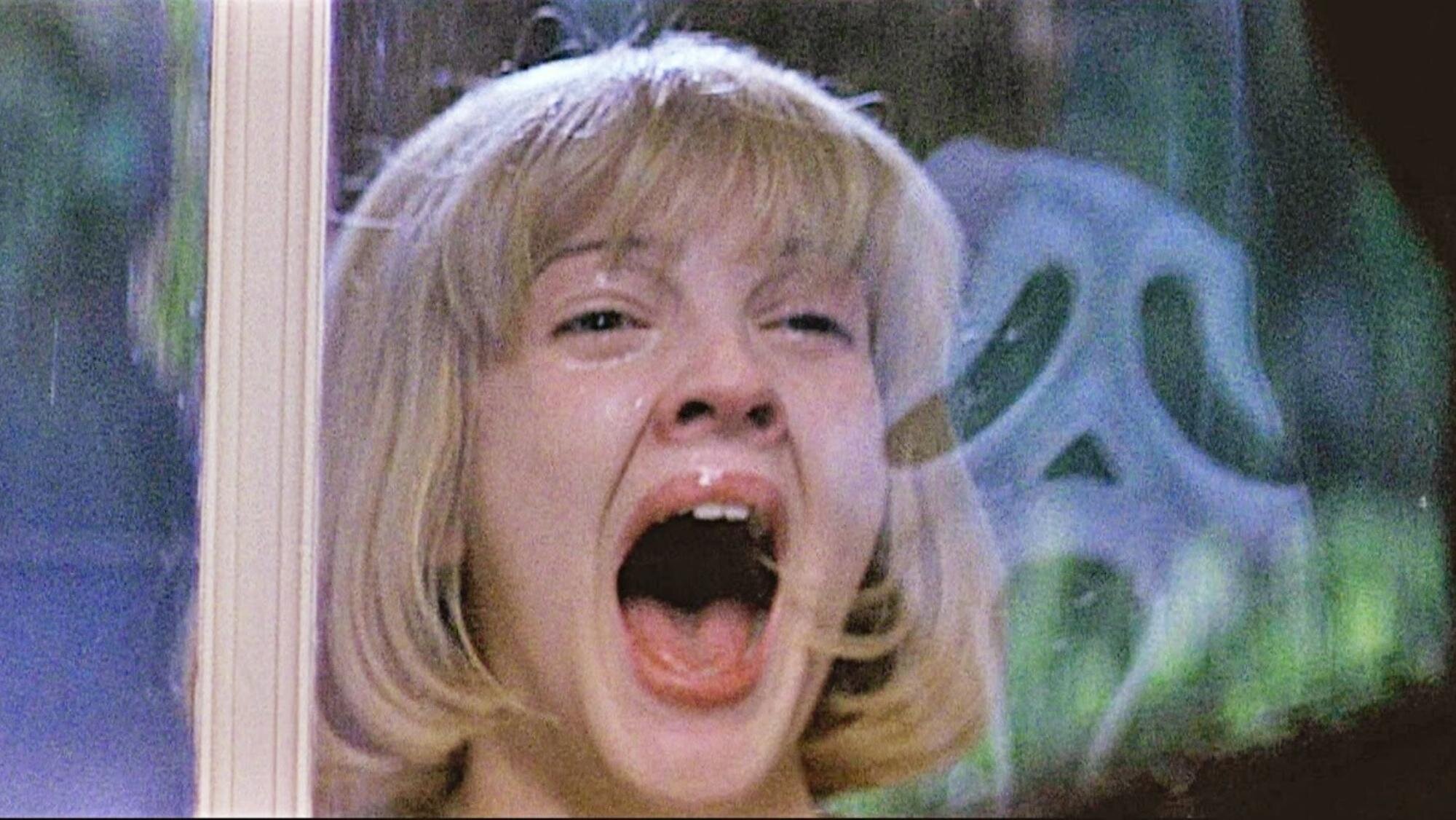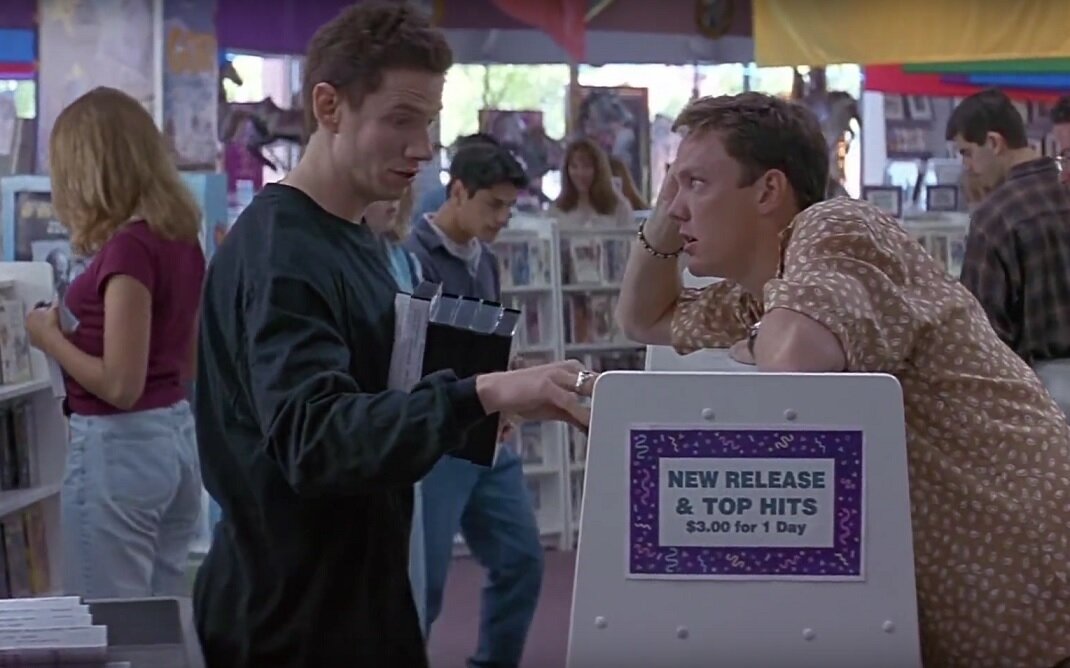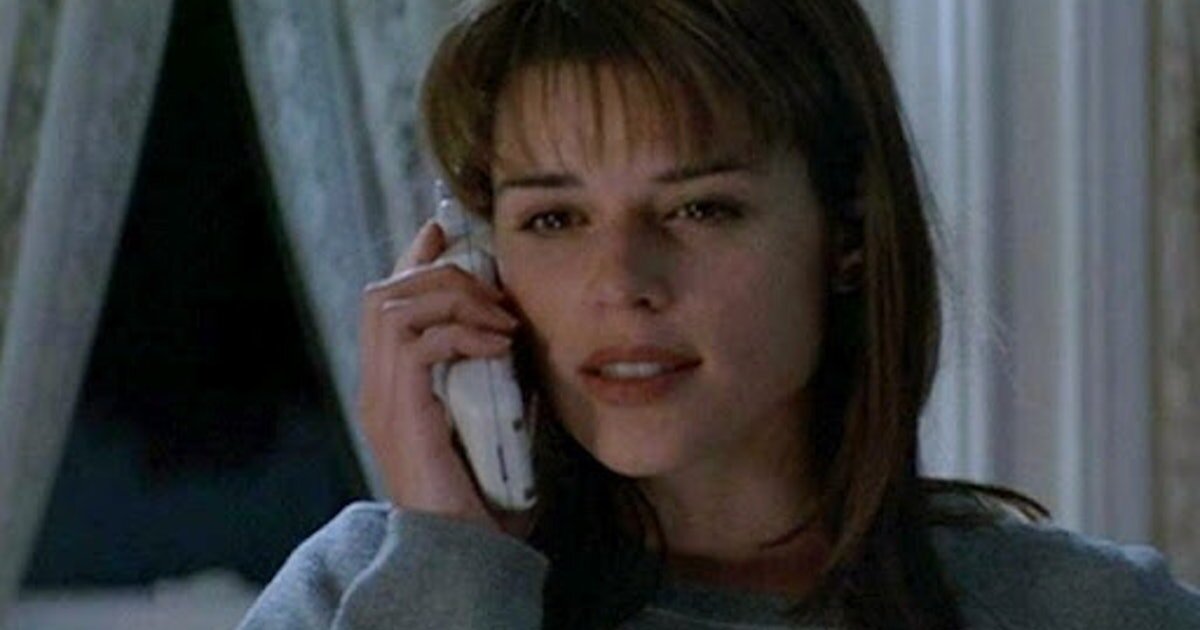Catastrophic Plan: The Legacy of Billy Loomis in Scream
BEWARE SPOILERS: We go into every post assuming you’ve already watched the film being discussed.
Let’s talk about the 1996 meta-horror film Scream, a cult classic and playful slashfest that, at the time of its release, breathed new life into a withering genre. The film follows Sidney Prescott (Neve Campbell), a teenager nearing the first anniversary of her mother’s murder when she finds herself the main target of a killer known as Ghostface rampaging through her town in a one-size-fits-all Halloween ghost costume.
Directed by Wes Craven and boasting a star-studded ‘90s cast, Scream became the pop-culture archetype for postmodernism and metafictional comedy, in which the characters acknowledge, discuss, indulge in, and attempt to subvert horror clichés and tropes.
Contrary to popular belief, it’s not the first film to modernize, satirize, and deconstruct horror movies. Fright Night (1985), the short film collection Creepshow (1982), and its first sequel in 1987 played important roles in helping revolutionize campy self-referential goodness in horror. But Scream remains a meta-horror masterwork of the knock-off and sequel-laden 80s and 90s slasher genre. Following in its footsteps, movies like 2011’s Cabin in the Woods and 2019’s Ready or Not have taken up the mantle of slasher satire for a new generation.
Given its massive influence as a popular and critical hit, Scream has been written about a lot. Most commonly, writers have tended to focus on the horror movie rules Randy (Jamie Kennedy) established during Stu’s (Matthew Lillard’s) Screw-the-Curfew-School’s-Out! party, the film’s repetition of the idea that viewing horror movies has desensitized Kids These Days to violence, and the film’s intertextuality (academic speak for it talks about, in this case, other horror movies and pop culture).
That’s all well and good, and I’ll try not to bore you by rehashing it here. Rather, I’m interested in how the movie has changed in this post-#metoo world, now seeming to offer a critique of domineering misogyny and gaslighting, reflected in the film’s use of Nick Cave and the Bad Seeds’ creepy, mysterious, broody, and catchy-as-hell “Red Right Hand.”
“He’s a Ghost, He’s a God, He’s a Man, He’s a Guru”
A little on this gem of a song: according to Nic Fildes, writing for the Financial Times, the term “red right hand,” inspired by John Milton’s epic poem Paradise Lost, “represents divine vengeance.” The wrath of God, you might say. And in this 2016 New York Post article about the song’s new role as the Peaky Blinders’ theme song, former Bad Seed Mick Harvey tells writer Hardeep Phull that even as co-writer he’s never quite known what the song means, claiming that “it’s better that it’s unknowable and spooky. The song has its own life, now.”
The Bad Seeds had a lot of really amazing music in the 90s, and “Red Right Hand” is probably at the top of the list. There aren’t many songs you’d expect to hear in both Scream and Dumb and Dumber. On its own, you wouldn’t think it would fit in a comedy, but the epic melodrama Nick Cave’s so good at really punches up the comedy in the “little old lady” scene of Dumb and Dumber and adds another surprising layer of depth to Scream.
The song’s all about “divine vengeance.” The lyric “He’s a ghost, he’s a god, he’s a man, he’s a guru,” describes an unknowable figure wielding horrific godlike power, a well-worn horror slasher villain archetype, one who appears in Scream as Ghostface. Like a ghost, the slasher villain only has to walk menacingly while you sprint, and somehow he catches up to you. Wielding the power to take away life, the slasher villain is godlike and often apparently immortal. The slasher villain is very often male and frequently prone to fits of human rage, sorrow, and jealousy, which he unleashes most viciously against the women around him. He knows all. You can’t hide from him, and most often you can’t outsmart him.
In Your Nightmares & in Your Dreams
Like other archetypal killers who’ve come before him, Ghostface leaves behind a legacy of violence, ensuring willing successors will take up the mantle and continue his work in the movie’s sequels.
While his successors come with their own motives, thereby transforming his legend, this Ghostface, embodied by two men, leaves a legacy of male violence against women. Women aren’t his only victims, but they are the ones Ghostface seems to enjoy torturing. We see this when he electrocutes Tatum Riley (Rose McGowan) and crushes her neck with a garage door. We see it when he terrorizes Sidney throughout the film. We see it when he reveals his violent, misogynistic motive and that he was the one who murdered Sidney’s mother:
We did your mom a favor, Sid. That woman was a slut-bag whore who flashed her shit all over town. … Your slut mother was fucking my father, and she’s the reason my mom moved out and abandoned me.
In fact, his violently claimed entitlement and male supremacy are the first things we learn about Ghostface when, in the opening scene, he toys with Casey Becker (Drew Barrymore). He asks what she’s doing, whether she has a boyfriend, what’s her favorite scary movie before revealing he’s right outside watching her and has her boyfriend Steve tied to a chair on the back patio. He demands Casey answer horror movie trivia, and she quickly learns her life and her boyfriend’s depend on answering correctly. Of course, Ghostface plans to kill them regardless, but we have to wait for him to establish the kind of predator he fancies himself first. So, when Casey incorrectly names Jason as the initial killer in Friday the 13th, Ghostface the Guru chastises her for not knowing that, in the first film, it’s actually Jason’s mom. For her wrong answer, Ghostface guts Steve, making sure Casey watches before he kills her.
By contrast, when Ghostface kills other men, like Steve, their deaths are either quick or purposeful. Steve’s disemboweling is meant to terrorize Casey, and stabbing Principal Himbry (Henry Winkler) and then making a spectacle of him gives Ghostface the distraction needed to get a bunch of drunken teens to leave Stu’s party. (Eric also argues that Principal Himbry crossed a line when he put the Ghostface mask on, just in that moment in his office. It’s not outlined in Randy’s Rules or anything, but the way the music changes when he puts it on, the way the camera lurks, it’s clear the mask foreshadows death, and The Fonz made a fatal transgression, sealing his fate.) Kenny the cameraman, whose throat is slit the night of the party, is just in the wrong place at the wrong time. (And with the wrong name. It’s the mid-90s. His name’s Kenny. Obviously he’s going to die.)
After the first two deaths, the movie re-focuses on Sidney, and viewers are introduced to her manipulative killer boyfriend, Billy Loomis (Skeet Ulrich), and her friends Tatum, Randy, and Stu (Tatum’s boyfriend). Tatum is immediately established as the sexualized friend. She wears crop tops and miniskirts and sucks on lollipops. Fifteen years after Scream, Cabin in the Woods continues the film’s work by laying out five archetypal horror figures: the Whore, the Virgin/Final Girl, the Athlete, the (sometimes wise) Fool, and the Scholar. Tatum, Scream’s apparent Whore, is at high risk in a slasher because men who hate women use women’s bodies, clothes, and behavior to justify sexual violence and murder.
If you’ve ever watched the original Fright Night, Stu and Randy feel like “Evil Ed” Thompson (Stephen Geoffreys) split in two, Randy inheriting Ed’s knowledge and Stu absorbing the violent, self-serving tendencies, while also parodying Ed’s susceptibility.
Stu and Randy are both introduced as Fools. Because Ghostface has established himself a horror Guru, the film directs suspicion at our movie buff Randy once or twice, but the murderer’s accomplice is Stu. And he tells us himself early on, while discussing Casey and Steve’s horrible fates, gleefully insisting, “[it] takes a man to do something like that.” This feels like a deranged and misogynistic boast because it is. Dude’s a murderer who casually sends his girlfriend to the garage during his party so his pal can torture and kill her. Ghostface the Guru is also a Man, one obsessed by his hatred of women, one with the godlike ability to be in two places at once.
From the start, Ghostface wastes no time in messing with Sidney after killing Casey and Steve. He calls her up the next night while she waits for Tatum to pick her up for a sleepover while her dad’s out of town. At first, convinced Randy’s prank calling her, she confesses she doesn’t watch scary movies:
They’re all the same. Some stupid killer stalking some big-breasted girl who can’t act who’s always running up the stairs when she should be going out the front door. It’s insulting.
Turns out it’s not Randy on the phone, and when she hangs up, Ghostface attacks. It also turns out she can’t make it out the front door because it’s locked and Ghostface is right there, ready to kill her if she takes a moment to unlock it. So up the stairs she goes. Eventually, she gets Ghostface to back off. At least, that’s what it seems like. When Billy comes in through her window soon after, though, he drops his phone, and Sidney freaks--because most 90s teens don’t carry around bulky cell phones. Because they’re expensive and no one else has them. So who would you call? Obviously cell phones are suspicious. Billy tries to convince her he’s not the attacker, but Sidney’s not dumb. She has him arrested even though she’s made to feel like she’s crazy for doing so. That feeling is only emphasized when she receives another threatening call at Tatum’s house when Billy’s still in custody, supposedly clearing his name.
Of course, as you know, Sidney was right. The reality is that her boyfriend has been gaslighting her throughout their entire relationship. And she can never truly escape him or his legacy. With new killers taking up the mantle in the sequels, Billy’s presence will always be felt. The Guru, the Man who murdered her mother and tried to kill her, continues to terrorize her even after his death. He’s a Ghost. He’s a God.
In Your Head, on the TV Screen
Once Billy’s released from police custody, he and Sidney make up. He even gets her to apologize for being too self-involved in her grief--because it’s apparently not okay to feel trauma and stress at the approach of the first anniversary of her mother’s death, and because it can’t possibly be Billy. He was locked up during that second call! She must be crazy to still think the boyfriend who climbs through her window at night and just wants her to be less prudish could be the killer.
There’s an interesting moment that amplifies her gaslit mental state. While Sidney eavesdrops on two girls talking about her, the murders, and her most recent trauma, the echo of their voices is much more pronounced than what you’d normally expect in a bathroom. One of them insists Sidney’s the real culprit. That it’s not her boyfriend, or her father (who the authorities can’t track down), or anyone else. Maybe Sidney’s the murderer. The scene serves as a literal echo chamber, in which we’re hearing Sidney’s anxieties through the voices of other characters, as if they were voices in her head. After the girls leave, Sidney comes out of the stall, stares at herself in the mirror, and mutters “pathetic.” She’s not, of course, but her killer boyfriend and his murder buddy have certainly made her feel that way.
The gaslighting reaches a metafictional level when Billy tells Sidney that life is just like a movie, but “you can’t pick your genre,” knowing full well that he’s picked the genre for her because he wants her to suffer like a “big-breasted girl” in a slasher. But Sidney is our Virgin/Final Girl (another slasher archetype covered in Cabin in the Woods and first defined by Carol J. Clover in her 1992 book Men, Women, and Chain Saws). She’s uncorrupted by violent media--because she doesn’t watch it--and modernized enough that the eventual decision to have sex won’t seal her fate like Billy tells her it will. Sure, according to Randy, Rule #1 of surviving a horror movie is “you can never have sex,” but Rule #2 is no drinking or drugs, told to a house full of drunken teens who don’t actually die, and you have to know the rules to break the rules, right?
Microscopic Cogs, Catastrophic Plans
Speaking of sex, things feel more than uncomfortable when you unpack the bizarrely complicated relationships Sidney and Tatum have found themselves in and who they’ve been intimate with. Basically, they’ve engaged in sexual acts under false pretenses. Because, you know, their boyfriends are murderers. Which, if the girls had known the truth earlier, definitely would have been big deal-breakers. No one wants to find out that her boyfriend and her friend’s boyfriend are violent psychopaths who get off on torture and murder and have been planning a spree they want to pin on her dad.
Okay, so maybe it’s more accurate to say that the manipulative Billy Loomis is a violent psychopath. Stu’s more of a sponge. The film sarcastically (but also kind of seriously) quips that exposure to too many horror flicks and other violent media will warp the mind. Except that there’s also fellow Guru/Fool Randy, who’s not a killer and doesn’t display the same male entitlement or sadism Stu and Billy possess. He just likes scary movies, and he’s seen enough of them to know that the missing, suspected dad is nothing more than a red herring. The prime suspect is still the boyfriend because “there’s always some stupid bullshit reason to kill your girlfriend.”
The dramatic irony here (by the way, just to define an often misunderstood term, “dramatic irony” is when the audience understands something meaningful about a situation that a character doesn’t) is that, even though Randy’s right, he doesn’t realize he’s discussing this with Ghostface. Or Ghostface’s accomplice. Whatever. Stu’s own self-professed motive is simple compared to Billy’s whole “Your mom broke up my family, so I’m gonna kill you” schtick: “Peer pressure,” Stu says. “I’m far too sensitive.”
Perhaps the film’s best line is when Stu, dizzy from blood loss, asks if Sidney really called the police and, when she says yes, cries out, “My mom and dad are gonna be so mad at me!” Yeah dude. You killed people.
In the end, even Stu is inconsequential in Billy Loomis’ grand plan, knowingly stabbed too deeply by his “friend” and eventually falling victim to “violent media” both figuratively and literally when Sidney uses the television to crush his head. Because Stu, like everyone else, is little more than a microscopic cog. Because that shady, mysterious, blood-soaked figure never had a true partner in crime. Just an unwitting pawn. It’s always just been Billy, a Ghost, a God, a Man, a Guru intent on leaving behind a legacy of violent misogyny. And in that way, Randy’s right.
It couldn’t have been anyone else.












